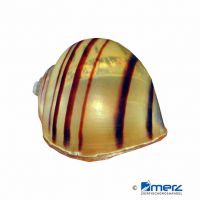Zebra Apple Snail (Asolene spixii)
| Zebra Apple Snail Asolene spixii | |
|---|---|
| Name | Zebra Apple Snail |
| Name Lat. | Asolene spixii |
| Family | Apple Snails |
| Family lat. | Ampullariidae |
| Order | Architaenioglossa Snails |
| Order lat. | Architaenioglossa |
| Origin | South America |
| Habitat | Streams, pools |
| Diet | Detritus, algae, vegetables |
| pH | 6.5-8.5 |
| Behavior | Peaceful |
| Keeping | Individual, pair, group |
| Care Level | Easy |
| Reproduction | Oviparous |
| Breeding | Simple |
| Life Span | 1-3 years |
| Protection | No |
| Metric Units | |
| Size | 2-4 cm |
| Temperature | 16-26 °C |
| Hardness | 5-10 °dH |
| Aquarium | 60 l |
| US Units | |
| Size | 0.8"-1.6" |
| Temperature | 61-79 °F |
| Hardness | 89-178 ppm |
| Aquarium | 15 gal |
Distribution and habitat
The range of the crepuscular to nocturnal zebra apple snails is southeastern Brazil, where they occur in a variety of habitats. They live in slow flowing and stagnant waters, swamps and floodplains with dense underwater vegetation and muddy soft bottoms.
Maintenance
They need a well-structured aquarium, with plenty of aquatic plants, roots and stones. The burrowable substrate of sand or fine gravel should be partially covered with foliage (e.g. sea almond leaves, oak leaves), decaying plant material and mulm. Slightly shaded light (floating plants), a weak current and slightly alkaline water is ideal.
Water quality must be that required for average freshwater fish keeping. No ammonia, ammonium and nitrite should be detectable in the water and the nitrate value should be below 100 mg/l. When using a filter, make sure that only a weak current is created and that no animals can be sucked in. The lighting must correspond to the natural day-night rhythm of the animals.
Diet
They feed mainly on dead and living plants, but also on carrion and detritus. In addition, besides the food accumulating in the aquarium, regularly over-broken leaves (lettuce, dandelion, etc.), cucumber slices and sinking dry food (granules, pellets, tablets) with a high vegetable content should be fed.
Feeding should be varied to prevent the occurrence of deficiency symptoms. Unaccepted food must be removed after 2-3 hours.
Behaviour and compatibility
They should be kept in a small group of 4-6 animals. Socialization with fish and other invertebrates (shrimp, snails), which do not consider these snails as food, is well possible
Basically, only mutually compatible species with similar requirements for water conditions and water temperature should be socialized.
Reproduction and breeding
They are separately sexed. The sexes can hardly be distinguished from each other. The males have a rounder shell opening than the females. If the shell is not too dark, the ovary of the females can be seen shining through
After mating, the female lays the clutch on smooth surfaces (e.g. leaves, aquarium glass) below the water surface. The grape-like clutch is surrounded by a gelatinous mass. Depending on the water temperature, the young snails hatch after about 10 days.
Important
They like to burrow. With sufficient vegetable supplementary feeding, the aquarium plants are spared.
With their lid they can close the shell so that they survive some time out of the water
To build their enclosure they need a sufficient supply of lime. Especially in soft, acidic water, shell damage (holes) can occur due to a lack of lime, which can lead to the death of the snail. Therefore, special attention should be paid to the calcium concentration in the water and, if necessary, calcium should be added in the form of limestone, cuttlebone or special preparations from the specialized trade.
The well-being of the animals should be checked regularly. The temperature should be checked daily, the pH value, hardness and nitrate value at least every 14 days. Regular partial water changes are recommended, even if the pollutant load has not yet reached the upper limit. Sudden changes in water quality should be avoided. Newly introduced animals must be accustomed slowly to the water in the aquarium
Further literature can be found in your pet store.
References
Text: Barbara Pachner; Image: Merz Zierfischgroßhandel
Source: BITTER (2008): Schnecken-Fibel, Dähne Verlag; ENGELMANN & LANGE (2011): Zootierhaltung - Tiere in menschlicher Obhut: Wirbellose, Verlag Harri Deutsch
